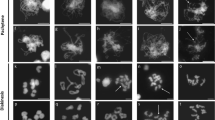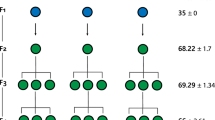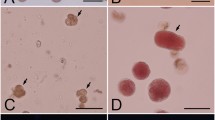Summary
Barley (Hordeum vulgare L. ‘Himalaya’) seeds were artificially aged under two storage conditions (32 °C/12% moisture content (m.c.) and 38 °C/18% m.c.) to study the behavior of induced chromosomal aberrations during plant growth. The frequencies of aberrant anaphases at first mitosis in root tips were correlated with loss of germinability. However, after 3 and 5 weeks' growth, aberration frequency declined. In plants grown from artificially aged seeds, the frequency of aberrant anaphases appeared to be stabilized at about 1% after 5 weeks' growth, in spite of the large differences in the frequencies at first mitosis. This suggests that because of their genetic imbalance, cells with chromosomal aberrations induced by seed aging were being excluded during plant growth. Meiotic chromosome configurations at MI were normal (7 II) in all plants studied, although a few precocious separations were found. Meiotic aberrations were found at AI-TI, AII-TII and the tetrad stages in the pollen mother cells of plants grown from the control and artificially aged seeds. However, there were no clear differences among the control and the two aging treatments. It was obvious that some cells with meiotic chromosomal aberrations were lost between the AI-TI and AII-TII stages, and still more between the AII-TII and tetrad stages. The frequency of tetrads with micronuclei in plants produced from artificially aged seeds was the same as in the control. The plants grown from artificially aged seeds showed high pollen fertility (95.2 to 97.0%) and seed fertility (90.1 to 97.2%) which was comparable to the control values (97.4 and 97.9%) respectively, indicating no special effects of seed aging. Anaphase cells of the first mitosis in the next (A2) generation were analyzed to study the transmission of chromosomal aberrations through mitotic and meiotic cell divisions in the A1 generation. Aberrant anaphases in the progeny from the artificially aged seeds were not higher than those of the control progeny. This indicates that the chromosomal aberrations induced by seed aging are not transmitted to the next generation.
Similar content being viewed by others
References
Abdalla FH, Roberts EH (1968) Effects of temperature, moisture, and oxygen on the induction of chromosome damage in seeds of barley, broad beans, and peas during storage. Ann Bot 32:119–136
Abdalla FH, Roberts EH (1969) The effect of seed storage conditions on the growth and yield of barley, broad beans, and peas. Ann Bot 33:169–184
Adams JD, Nilan RA (1958) After-effects of ionizing radiation in barley. 2. Modification by storage of X-irradiated seeds in different concentrations of oxygen. Radiat Res 8:111–122
Allard RW (1970) Problems of maintenance. In: Frankel OH, Bennett E (eds) Genetic resources in plants — their exploration and conservation. IBP Handbook No. 11. Blackwell Scientific, Oxford, pp 491–494
Avanzi S (1960) Primi dati sulla radioresistenza relativa dell'apice del germoglio e dell'apice della radice nel seme di orzo. Genet Agrar 13:113–122
Avery AG, Blakeslee AF (1936) Visible mutations from aged seeds. Am Nat 70:36–37
Avery AG, Blakeslee AF (1943) Mutation rate in Datura seed which had been buried 39 years. Genetics 28:69–70
Caldecott RS, Smith L (1952) A study of X-ray-induced chromosomal aberrations in barley. Cytologia 17:224–242
Cartledge JL, Blakeslee AF (1934) Mutation rate increased by aging seeds as shown by pollen abortion. Proc Natl Acad Sci USA 20:103–110
Cartledge JL, Barton LV, Blakeslee AF (1936) Heat and moisture as factors in the increased mutation rate from Datura seeds. Proc Am Philos Soc 76:663–685
D'Amato F (1951) Mutazioni cromosomiche spontanee in plantule di Pisum sativum L. Caryologia 3:285–293
Gaul H (1957) Zur Frage der ontogenetischen Elimination mutierter Zellen nach Röntgenbestrahlung von Samen. Naturwissenschaften 44:566
Gerassimova H (1935) The nature and causes of mutations. 2. Transmission of mutations arising in aged seeds: occurrence of “homozygous dislocants” among progeny of plants raised from aged seeds. Cytologia 6:431–437
Gisquet P, Hitier H, Izard C, Mounat A (1951) Mutations naturelles observées chez N. tabacum L. et mutations expérimentales provoquées par l'extrait à froid de graines vieillies prématurément. Ann Inst Exp Tab Bergerac 1:5–36
Gunthardt H, Smith L, Haferkamp ME, Nilan RA (1953) Studies on aged seeds. 2. Relation of age of seeds to cytogenetic effects. Agron J 45:438–441
Harrison BJ (1966) Seed deterioration in relation to storage conditions and its influence upon germination, chromosomal damage and plant performance. J Natl Inst Agric Bot 10:644–663
Harrison BJ, McLeish J (1954) Abnormalities of stored seed. Nature 173:593–594
International Board for Plant Genetic Resources (1976) Report of IBPGR working group on engineering, design, and cost aspects of long-term seed storage facilities. IBPGR Secretariat, Rome, pp 1–19
Kato Y (1954) Descriptive and experimental cytology in Allium. 2. Chromosome breakage in the seedling of Allium. Bot Mag 67:122–128
Kihara H (1937) Genomanalyse bei Triticum und Aegilops. 7. Kurze Übersicht über die Ergebnisse der Jahre 1934–1936. Mem Coll Agric Kyoto Univ 41:1–61
Khush GS (1973) Cytogenetics of aneuploids. Academic Press, New York London
Murata M (1979) Genetic changes induced by artificial seed aging in barley. PhD Dissertation, Colorado State University, Fort Collins, 185 p
Murata M, Roos EE, Tsuchiya T (1981) Chromosome damage induced by artificial seed aging in barley. 1. Germinability and frequency of aberrant anaphases at first mitosis. Can J Genet Cytol 23:267–280
Murata M, Tsuchiya T, Roos EE (1982) Chromosome damage induced by artificial seed aging in barley. 2. Types of chromosomal aberrations at first mitosis. Bot Gaz 143:111–116
Nawaschin M (1933) Altern der Samen als Ursache von Chromosomenmutationen. Planta 20:233–243
Nawaschin M, Gerassimowa H (1936a) Natur und Ursachen der Mutationen. 1. Das Verhalten und die Zytologie der Pflanzen, die aus infolge Alterns mutierten Keimen stammen. Cytologia 7:324–362
Nawaschin M, Gerassimowa H (1936b) Natur und Ursachen der Mutationen. 3. Über die Chromosomenmutationen, die in den Zellen von ruhenden Pflanzenkeimen bei deren Altern auftreten. Cytologia 7:437–465
Nichols C (1941) Spontaneous chromosome aberrations in Allium. Genetics 26:89–100
Peto FH (1933) The effect of aging and heat on the chromosomal mutation rates in maize and barley. Can J Res 9:261–264
Roberts EH (1973) Loss of viability: chromosomal and genetical aspects. Seed Sci Technol 1:515–527
Roberts EH (1975) Problems of long-term storage of seed and pollen for genetic resources conservation. In: Frankel OH, Hawkes JG (eds) Crop genetic resources for today and tomorrow, vol 2. Int Biol Progr. Cambridge University Press, London New York Melbourne, pp 269–296
Roberts EH (1978) Mutations during seed storage. Acta Hortic 83:279–282
Roos EE (1982) Induced genetic changes in seed germplasm during storage. In: Khan AA (ed) The physiology and biochemistry of seed development, dormancy, and germination. Elsevier Biomedical Press, Amsterdam, pp 409–434
Sax K (1941) The behavior of X-ray induced chromosomal aberrations in Allium root tip cells. Genetics 26:418–425
Schkwarnikow PK (1937) Über Erhöhung der Mutationsrate bei Weizen nach langer Aufbewahrung der Samen. Genetica 19:188–199
Sigurbjornsson B, Micke A (1969) Progress in mutation breeding. Induced mutations in plants. Proc FAO/IAEA Symp Nat, induction and utilization of mutations in plants. FAO/IAEA, Vienna, pp 673–698
Author information
Authors and Affiliations
Additional information
Communicated by F. Mechelke
Published with the approval of the Director of the Colorado state Experiment Station as Scientific Series No. 2776
Rights and permissions
About this article
Cite this article
Murata, M., Tsuchiya, T. & Roos, E.E. Chromosome damage induced by artificial seed aging in barley. Theoret Appl Genet 67, 161–170 (1984). https://doi.org/10.1007/BF00317025
Received:
Accepted:
Issue Date:
DOI: https://doi.org/10.1007/BF00317025




